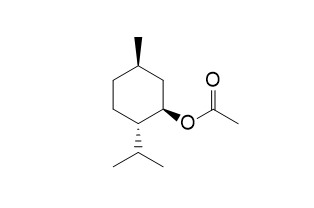(1R)-(-)-Menthyl acetate
Reference standards.
Inquire / Order:
manager@chemfaces.com
Technical Inquiries:
service@chemfaces.com
Tel:
+86-27-84237783
Fax:
+86-27-84254680
Address:
1 Building, No. 83, CheCheng Rd., Wuhan Economic and Technological Development Zone, Wuhan, Hubei 430056, PRC
Providing storage is as stated on the product vial and the vial is kept tightly sealed, the product can be stored for up to
24 months(2-8C).
Wherever possible, you should prepare and use solutions on the same day. However, if you need to make up stock solutions in advance, we recommend that you store the solution as aliquots in tightly sealed vials at -20C. Generally, these will be useable for up to two weeks. Before use, and prior to opening the vial we recommend that you allow your product to equilibrate to room temperature for at least 1 hour.
Need more advice on solubility, usage and handling? Please email to: service@chemfaces.com
The packaging of the product may have turned upside down during transportation, resulting in the natural compounds adhering to the neck or cap of the vial. take the vial out of its packaging and gently shake to let the compounds fall to the bottom of the vial. for liquid products, centrifuge at 200-500 RPM to gather the liquid at the bottom of the vial. try to avoid loss or contamination during handling.
Front Pharmacol.2025, 16:1611342.
JPC-Journal of Planar Chromatography2023, 36:179-190
J Agric Food Chem.2024, 72(49):27139-27149
Geroscience.2024, 01207-y.
Pathol Res Pract.2024, :260:155445.
Nutrients.2024, 16(22):3805.
Molecules.2023, 28(7):3039.
Analytical Letters 2021, 54(4).
J of Liquid Chromatography & Related Technologies2024, 47(1-5):14-25.
Prev Nutr Food Sci.2024, 29(4):504-511.
Related and Featured Products
Chemical Papers- Slovak Academy of Sciences, 2017, 71(4):785–793.
Efficient Candida rugosa lipase immobilization on Maghnite clay and application for the production of (1R)-(−)-Menthyl acetate.[Reference:
WebLink]
This work focused on the identification of natural, economical, and efficient supports for immobilization of Candida rugosa lipase (CRL) to catalyze the resolution of (±)-menthol.
METHODS AND RESULTS:
To this purpose, CRL has been immobilized on natural montmorillonite from Algeria (Maghnite-H), ion-exchange resins (Amberjet®1200-H and Amberjet®4200-Cl), and diatomaceous earth (Celite®545). After a preliminary screening of supports, the immobilization of CRL led to a markedly improved enantioselectivity. Excellent enantioselectivity (E ≥ 134) was achieved by the four supported lipases (E = 68 for free enzyme). Compared to the three other supports tested, higher enantioselectivity was observed with Maghnite-H used as immobilization matrix. In this work, the effects of solvent, reaction time, and temperature, on the conversion as well as on enantioselectivity were investigated. The maximum of conversion (% C = 43%) with high enantiomeric excess of products (eep > 99) was obtained when the reaction is catalyzed by CRL immobilized on Maghnite-H at 30 °C for 24 h, and using toluene as selected solvent. Immobilized CRL on Maghnite-H exhibited good thermostability over a wide temperature range (30–90 °C) compared to the free one.
CONCLUSIONS:
These results suggest that CRL immobilized on Maghnite-H has good potential as biocatalyst for the production of (1R)-(-)-Menthyl acetate.
Chem Commun (Camb),2015 Jun 30;51(56):11252-5.
The crystalline sponge method: MOF terminal ligand effects.[Pubmed:
26081991]
Bromide and chloride analogs of the commonly used zinc iodide-based metal organic framework for the crystalline sponge method were synthesized and evaluated.
METHODS AND RESULTS:
Inclusion of (1R)-(-)-Menthyl acetate into these MOFs was analysed using third-generation synchrotron radiation, and the effects and potential benefits of varying the MOF terminal ligand are discussed.



